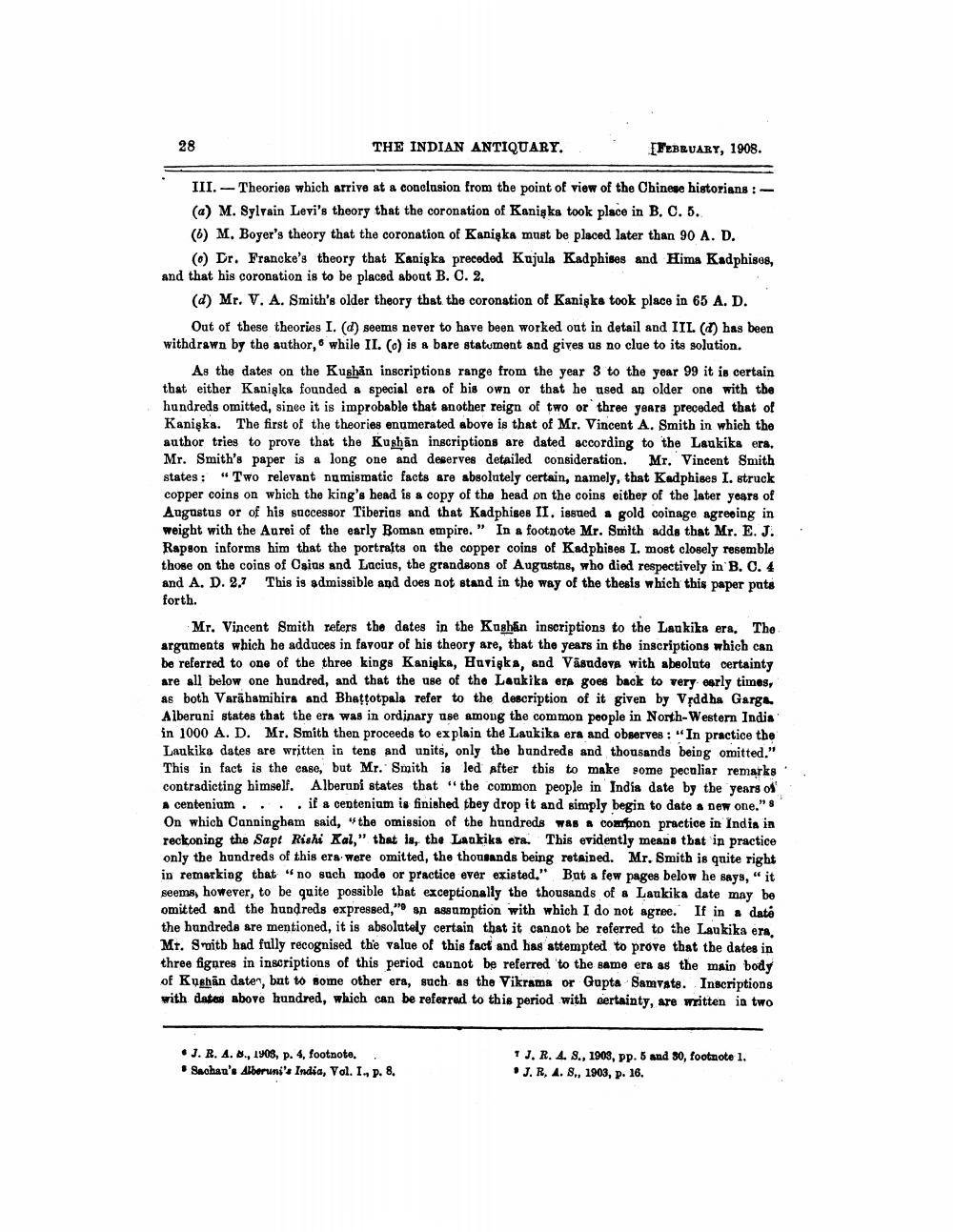________________
28
THE INDIAN ANTIQUARY.
[FEBRUARY, 1908.
III.-Theories which arrive at a conclusion from the point of view of the Chinese historians :(a) M. Sylvain Levi's theory that the coronation of Kanigka took place in B. C. 5. (6) M. Boyer's theory that the coronation of Kaniska must be placed later than 90 A. D.
(6) Dr. Francke's theory that Kanişka preceded Kujula Kadphises and Hima Kadphison, and that his coronation is to be placed about B. C. 2.
(d) Mr. V. A. Smith's older theory that the coronation of Kaniska took place in 65 A. D.
Out of these theories I. (d) seems never to have been worked out in detail and IIL () has been withdrawn by the author, while II. (.) is a bare statument and gives us no clue to its solution.
As the dates on the Kushan inscriptions range from the year 3 to the year 99 it is certain that either Kanişka founded a special era of his own or that he used an older one with the hundreds omitted, since it is improbable that another reign of two or three years preceded that of Kaniska. The first of the theories enumerated above is that of Mr. Vincent A. Smith in which the author tries to prove that the Kushan inscriptions are dated according to the Laukika era, Mr. Smith's paper is a long one and deserves detailed consideration. Mr. Vincent Smith states: "Two relevant numismatic facts are absolutely certain, namely, that Kadphises I. struck copper coins on which the king's head is a copy of the head on the coins either of the later years of Augustus or of his successor Tiberias and that Kadphises II. issued a gold coinage agreeing in weight with the Aurei of the early Boman empire.” In a footnote Mr. Smith adds that Mr. E. J. Rapson informs him that the portraits on the copper coins of Kadphises I. most closely resemble those on the coins of Osias and Lacius, the grandsons of Augustne, who died respectively in B. C. 4 and A. D. 2,7 This is admissible and does not stand in the way of the thesis which this paper pats forth.
Mr. Vincent Smith refers the dates in the Kushan inscriptions to the Laukika era. The arguments which he adduces in favour of his theory are, that the years in the inscriptions which can be referred to one of the three kings Kaniska, Harigka, and Vasudeva with absolute certainty are all below one hundred, and that the use of the Laukika ere goes back to very early times, as both Varāhamihira and Bhatotpala refer to the description of it given by Věddha Garga. Alberuni states that the era was in ordinary use among the common people in North-Western India in 1000 A. D. Mr. Smith then proceeds to explain the Laukika era and observes: "In practice the Laukika dates are written in tens and units, only the bundreds and thousands being omitted." This in fact is the case, but Mr. Smith is led after this to make some peculiar remarks contradicting himself. Alberuni states that "the common people in India date by the years of A centenium. ... if & centenium is finished they drop it and simply begin to date a new one." On which Canningham said, "the omission of the hundreds was a common practice in India in reckoning the Sapt Rishi Kal," that is, the Laskika era. This evidently means that in practice only the hundreds of this era were omitted, the thousands being retained. Mr. Smith is quite right in remarking that "no such mode or practice ever existed." Bat a few pages below he says," it seems, however, to be quite possible that exceptionally the thousands of a Laukika date may be omitted and the hundreds expressed," an assumption with which I do not agree. If in a date the hundreds are mentioned, it is absolutely certain that it cannot be referred to the Laukika era. Mt. Smith had fully recognised the value of this fact and has attempted to prove that the dates in three figures in inscriptions of this period cannot be referred to the same era as the main body of Kughan date, but to some other era, such as the Vikrama or Gupta Samvats. Inscriptions with dates above hundred, which can be referred to this period with sertainty, are written in two
.J.R.A.W., 1903, p. 4, footnote. . Sachan's Alberuni's India, Vol. I. p. 8.
TJ.R. 4. 8., 1903, pp. 6 and 80, footnote 1.
J. R. A. 8., 1903, p. 16.




